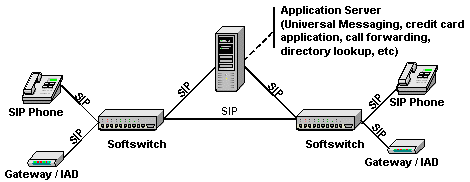Session Initiation Protocol (SIP) is a network protocol that enables connection between two or more participants, session initiation, and data transport through real-time protocols. SIP is widely used to initiate voice, video, chat or instant messaging, as well as interactive games and virtual reality sessions.
As SIP has become mandatory in many new technologies, including 3G and 4G phones, its use is increasingly common.
SIP can be used to control multimedia conferences, Internet telephony and multimedia distribution of the communication network.
How Does SIP Work?

SIP works with bidirectional interaction. For each SIP message, one device sends a request and the other device receives this request and then responds to that request.
1xx response codes mean that the device was received and processed the message. Codes starting with 2xx mean completion, 3xx are used for redirects.
The most common known code is 200, meaning the process was successfully completed without any further details.
The SIP protocol has many features. Its main features are:
- SIP is not tied to any particular media type and therefore, expanding media technologies can be quickly integrated.
- SDP (The Session Description Protocol) manages media details. RTP (Real-time Transport Protocol) manages the delivery of data. It is important to remember that SIP is located at the application layer of protocols and is only a signaling protocol. SIP itself does not handle any details of multimedia sessions.
- SIP supports end-to-end and authentication as well as end-to-end encryption using S/MIME.
- Members in a SIP session can associate with multiple points, a single point, or an all-inclusive structure. Additionally, SIP is independent of the substrate transport protocol.
- The software that implements the basic SIP protocol can be expanded with additional capabilities and is actively used for many media applications.
What is SIP Client?
SIP clients are IP (Internet Protocol) and Softphone phones.
SIP’s working principle is very similar to the HTTP (Hypertext Transfer Protocol). In this protocol, users are named as username@domain.
The SIP user can log in with other users or respond to the session requests received after the user subscribes to the server via internet protocol with a user agent. They communicate with messages specially designated for SIP applications.
SIP Requests and Responses
SIP Requests
REGISTER: It is the notification by user agents that they want to register internet protocol addresses to SIP servers.
Example signaling in RFC Documentation:
REGISTER sip: registrar.xxx.com SIP / 2.0 Via: SIP / 2.0 / UDP xxx.xxx.com:5060;branch=z9hG4bKnashds7 Max-Forwards: 70 To: Bob <sip: [email protected]> From: Bob <sip: [email protected]>; tag = 456248 Call-ID: 843817637684230 @ 998sdasdh09 CSeq: 1826 REGISTER Contact: <sip: [email protected]> Expires: 7200 Content-Length: 0
- INVITE: Refers to initiating a media session between clients.
- ACK: Confirms incoming SIP request messages.
- CANCEL: Does not retrieve a completed call while ending an already pending request.
- BYE: Terminates the session between two users.
- OPTIONS: Collects information about the caller’s capabilities, but does not make calls
SIP Responses
SIP responses are very similar to HTTP responses.

- 1xx = Informational answers. Example: 100 (trying), 180 (ringing).
- 2xx = Success answers. Example: 200 (ok)
- 3xx = Routing responses.
- 4XX = Request errors.
- 5xx = Server issues.
- 6xx = Global errors.
What’s the Difference Between SIP and VoIP?
While VoIP is a term that can be used to describe any internet-based telephony service, SIP is a communication protocol used for most types of VoIP distribution. VoIP technology has its roots in the 1970s. Although it is old, its use in the field of business technology has been very popular in the last 10 years.
VoIP over the internet instead of traditional phone lines is a broad term used for any phone call made from VoIP uses the data link to transmit voice packets instead of the Public Transfer Telephone Network (PSTN).
SIP is a protocol used in VoIP applications to initiate, maintain and terminate multimedia communication sessions. SIP protocols provide signaling and control of voice, video and messaging applications.
Which of SIP and VoIP is Right for You?
VoIP and SIP are tightly intertwined and comparing them with each other is not a very accurate.
VoIP does not need the SIP protocol as long as you use voice communication. There are several different Internet protocols that facilitate voice communication, but SIP is the most widely used. The SIP protocol also allows you to start a text, voice, or video chat session.
SIP extends basic VoIP capabilities beyond voice calling by allowing users to exchange messages, videos, files and other forms of data over an internet connection. For many companies, switching to SIP can save cost and productivity.
To use the technologies mentioned above, you can try Infoset free for 14 days. With Infoset, you can manage all your support and sales channels such as cloud call center, live chat, e-mail and social media from a single platform and offer your customers an extraordinary experience.






